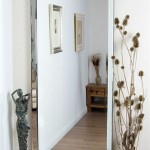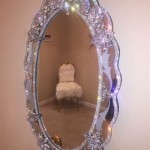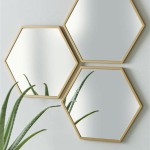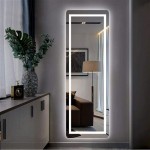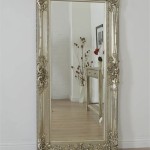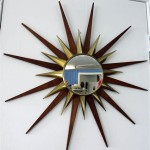How to Use Mirror Rosettes
Mirror rosettes offer a versatile decorative element for various design styles, from vintage to contemporary. Understanding their application and the available options ensures successful incorporation into any project.
Mirror rosettes are decorative accents typically made of plastic, wood, or metal designed to enhance the appearance of mirrors and other reflective surfaces. They often feature intricate designs and come in a range of sizes and finishes to complement different aesthetics.
Choosing the right mirror rosette depends heavily on the overall style of the mirror and the surrounding décor. For antique or vintage-inspired mirrors, ornate rosettes made of brass or resin with intricate detailing can enhance the classic look. Modern or minimalist designs may benefit from simpler, geometric rosettes in metallic finishes like brushed nickel or chrome.
Size consideration is critical for achieving a balanced and aesthetically pleasing result. Small rosettes can get lost on large mirrors, while oversized rosettes can overwhelm smaller frames. The rosette's size should be proportional to the mirror's dimensions and the surrounding decorative elements.
Before installing mirror rosettes, gather the necessary tools. These typically include a measuring tape, pencil, level, drill (if necessary), appropriate screws or adhesive, and the rosettes themselves. Having everything prepared beforehand streamlines the installation process.
Placement is a key factor in the overall impact of mirror rosettes. The most common placement is at the intersection of the frame and the mirror, particularly in the corners. However, depending on the design, rosettes can also be placed along the sides or top of the frame. Symmetrical placement is generally recommended for a balanced and harmonious look. Measure and mark the desired locations carefully before proceeding with installation.
The installation method depends on the type of rosette and the mirror frame. Some rosettes come with screws for direct mounting onto the frame, while others rely on strong adhesives. For screw-mounted rosettes, pre-drilling pilot holes is recommended to prevent the frame from cracking or splitting. When using adhesive, ensure the surface is clean and dry for optimal bonding.
Beyond their traditional use with mirrors, rosettes can be incorporated into various decorative applications. They can serve as embellishments on picture frames, furniture, or even wall paneling. Their versatility allows for creative integration into different design schemes, adding a touch of elegance and detail.
Regular cleaning helps maintain the appearance of mirror rosettes and prevents the buildup of dust and grime. Use a soft, damp cloth to gently wipe the surface of the rosettes. Avoid abrasive cleaners or harsh chemicals, as these can damage the finish. Regular dusting with a microfiber cloth can further help prevent the accumulation of dirt.
Different materials offer varying levels of durability and maintenance requirements. Metal rosettes, such as brass or nickel, are generally durable and resistant to wear and tear. Wooden rosettes may require occasional polishing or refinishing to maintain their appearance. Plastic rosettes are often the most affordable option but may be less durable than metal or wood.
Selecting the appropriate finish is essential for achieving the desired aesthetic. Antique finishes can lend a vintage charm, while brushed metallic finishes offer a more contemporary look. Consider the existing hardware and fixtures in the room when choosing a finish for the rosettes to ensure a cohesive design.
Exploring different styles of rosettes can open up a range of design possibilities. From simple and understated to elaborate and ornate, the chosen style should complement the overall design scheme. Researching different historical periods and design movements can provide inspiration and help in selecting the appropriate rosette style.
Working with uneven surfaces may present challenges when installing mirror rosettes. Flexible adhesives can help accommodate slight irregularities. In some cases, shims may be necessary to create a level surface for proper adhesion or screw mounting. Careful preparation and consideration of the surface are crucial for successful installation on uneven surfaces.
Repairing damaged rosettes depends on the extent of the damage and the material of the rosette. Minor scratches on metal rosettes can sometimes be buffed out with a polishing cloth. Broken pieces may require adhesive for reattachment. For significant damage, replacing the rosette might be the most viable solution.
The cost of mirror rosettes varies depending on the material, size, and intricacy of the design. Plastic rosettes are typically the most budget-friendly option, while handcrafted rosettes made of high-quality materials can be significantly more expensive. Consider the project budget when selecting rosettes.
By understanding the different aspects of using mirror rosettes, from selection and placement to installation and maintenance, individuals can effectively incorporate these decorative elements into their design projects, enhancing the beauty and elegance of their spaces.

Cast Brass Tudor Rose Mirror Rosette Rough Old Glass

12 Brass Mirror Rosettes Zc107

Silver Mirror Rosettes Antique Tiles Decor Wall

12 Brass Mirror Rosettes Zc103

Everbilt 2 In Star Mirror Rosette Clear 813958 The Home Depot

20thc Large Distressed Mirror With Rosette Detail At 1stdibs Rosettes Brass

12 Brass Mirror Rosettes Zc107

Everbilt Mirror Rosette Bud Clear With 3 4 In Stud 83348 The Home Depot

Cast Brass Tudor Rose Mirror Rosette Rough Old Glass

11 Mirror Rosettes Ideas Corner Antique


